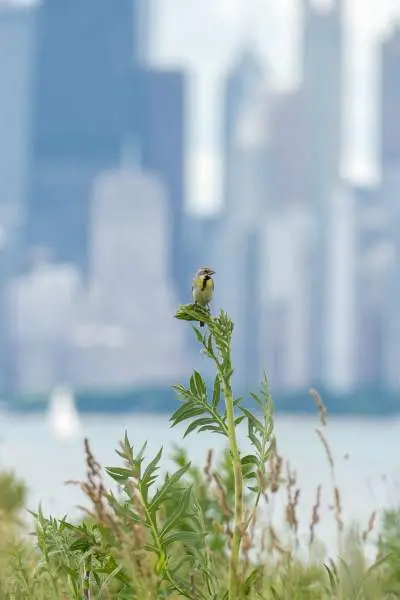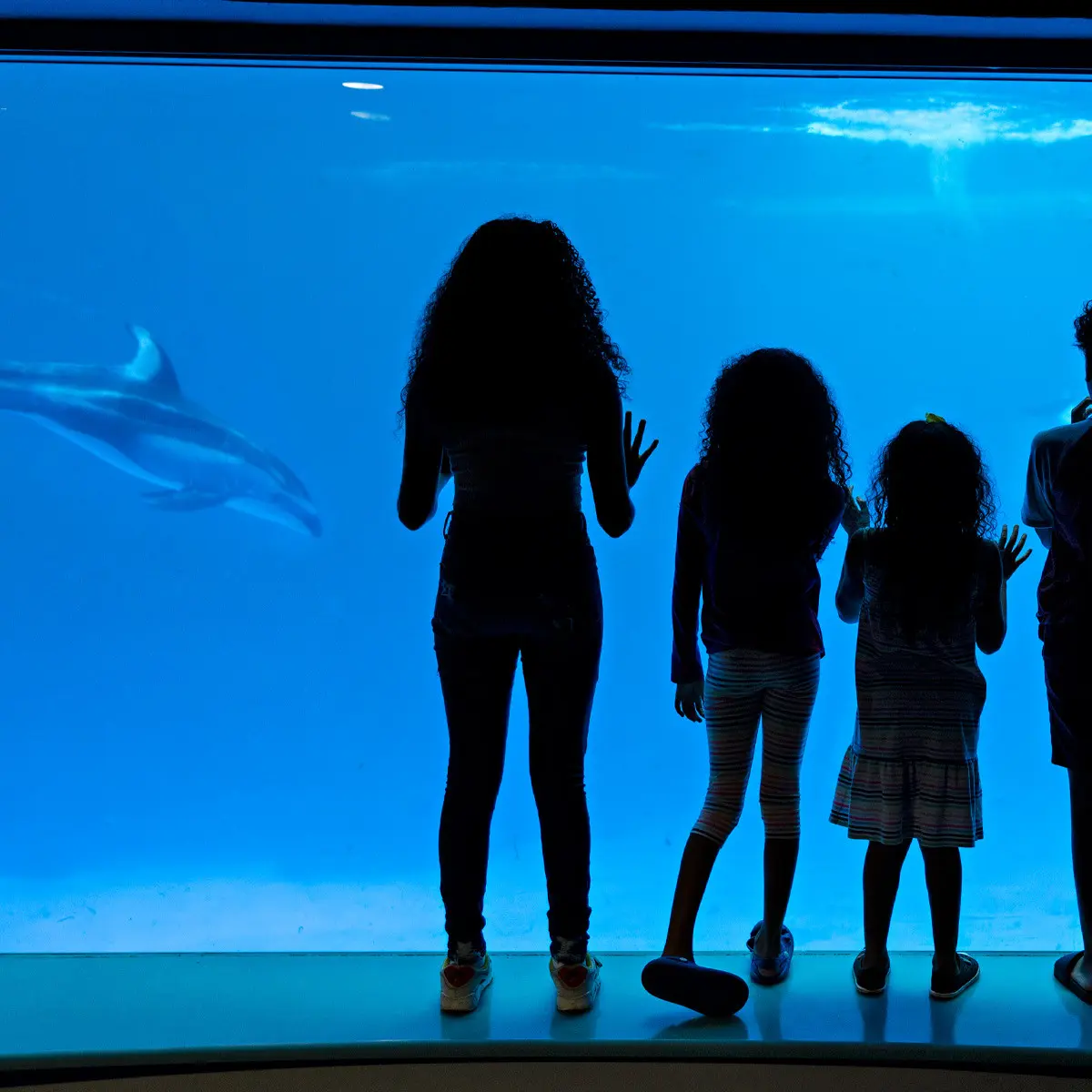
As a specialist with our state’s coastal program, I spend much of my time on Chicago’s coast.
But, birding on the city’s lakefront was a new experience for me. To learn the ropes, I invited my friend Stephanie Beilke, a life-long birder and conservation scientist at Audubon Great Lakes, a regional office of the National Audubon Society. Guided by Stephanie’s bird expertise, we found not only some truly colorful and mesmerizing birds, but also the joy of discovery.
The promise of discovery brings many new and experienced birders to the lakefront every year. To find a new type of bird for the season, especially one you may not usually find in Chicago at all, holds a certain kind of magic that beckons you to join the pursuit. Who knows — maybe you could be the first one to ever see that rare species.
Chicago is a Birder's Paradise
Every year, millions of birds travel migratory “flyways,” routes that take birds from their tropical wintering grounds in Latin America to the forests of Canada, where many will nest. Chicago’s lakefront is in the heart of the Mississippi Flyway, providing an important landing place to rest and refuel.
This itinerary takes you through three, must-see Chicago Park District birding sites on the city’s coast. You can make a day of it, or explore any one of them for hours. The sites overlook Lake Michigan, a landmark that helps migratory birds find their way. You will see the most migrating songbirds in May and now in September, but there are plenty of opportunities in Chicago year-round for excellent birding.
You can drive to any of the places in this piece, but they are particularly wonderful to explore by bike. You can hop on a short-term rental Divvy bike or your own bike and travel Chicago’s Lakefront Trail.



Montrose Point Bird Sanctuary
In the early morning, Stephanie and I set off to Montrose Point Bird Sanctuary with our binoculars, water and snacks, and the Audubon Bird Guide app to start birding. It is one of Chicago’s most popular birding sites, and one of the best spots to see spring and fall migration. The reason for this is simple. Montrose Point juts out into Lake Michigan. To an exhausted, traveling songbird, nothing could be more convenient. The sanctuary is famous for its “Magic Hedge,” a row of shrubs in the park that – like magic – attracts many kinds of birds.
Sunlight streaming through the trees, we entered the sanctuary and headed for the Magic Hedge. We were soon greeted by a Black-billed Cuckoo, faintly visible in the hedge and surrounded by a growing group of admirers. As we stood motionless, we could also hear in the brush the jarring call of the Gray Catbird. While the catbird may appear plain, its personality is anything but. Known for its cat-like “meow” call, the catbird also mimics other birds’ calls. Heading down the sanctuary path, we next spotted the welcoming brilliant orange of our first Baltimore Oriole of the season.
The sanctuary’s path takes you to the beach, where there are also many migratory shorebirds to see. On our way there, we spotted the bold red and yellow wing band of Red-winged Blackbirds as they moved from branch to branch and the graceful flight of Barn Swallows; both come to Montrose Point Bird Sanctuary in the early spring to nest, and return again in large flocks on their way south in the fall. At the beach, we ventured off the path to watch a family of Killdeer, but were careful not to get too close. Killdeer are known for distraction displays, where they can fake a wing injury to distract potential predators.


Northerly Island
Located near Chicago’s famous museum campus, Chicago Park District transformed Northerly Island from a former airport into a green oasis, with wild prairie grasses, walking paths, and a scenic lagoon. There is even a nearby outdoor amphitheater, if you would like to catch a concert after a day of birding.
Northerly Island is a less frequented birding spot, but still hopping with activity. The songs of the Yellow Warbler and Savannah Sparrow welcomed us on our way in, each bird greeting us with its unique personality. Sure enough, we spotted the bright yellow of the warblers who had greeted us with song, hopping from branch to branch in a jig-like dance. High above us, Northern Rough-winged Swallows and Chimney Swifts beat their wings wildly, performing aerial acrobatics in the hopes of catching some insects for lunch.
As we strolled the lagoon path, we spotted shorebirds, including Spotted Sandpipers and a Semipalmated Plover hustling for food. Ducks and American Coots floated effortlessly across the water, their regal posture hiding fast feet paddling below. Come back to Northerly Island in the late fall and early winter to see many more of these water birds in action.
Del Campo's Tacos
What is a better lunch after a morning of birding than tacos? Luckily for Stephanie and me, Del Campo’s Tacos is located just nearby Northerly Island Park and was the perfect spot to stop to eat. This small restaurant, tucked away by the Lakefront Trail, has authentic and delicious Mexican street food. Place your order by the window and then grab a seat at the restaurant’s back patio, where you can take in the city’s skyline. Del Campo’s closes during Chicago’s colder months, so make sure to visit their website ahead of time.

McCormick Bird Sanctuary in Burnham Park
Ever read about the Chicago World’s Fair held in 1893? Daniel Burnham was a famous Chicago architect and planner who brought to life a “White City” for Chicago’s south lakefront during the World’s Fair. Named in his honor, Burnham Park stretches almost 600 acres and includes a skate park, beaches, and important bird sanctuaries and natural areas like McCormick Bird Sanctuary.
McCormick Bird Sanctuary is also lesser-trafficked, and full of savannah and prairie habitat that is excellent for birding. It is always nice to have a birding spot to yourself, and particularly wonderful to end a day of birding that way. As we walked along McCormick’s woodchip path, Stephanie and I were the only people around and we caught an Indigo Bunting dart across the sky. Although their color fades from blue to brown as fall turns into winter, Indigo Buntings are particularly magnificent to see in the spring when the male’s feathers transform to a brilliant blue for mating season. As we ambled through the sanctuary, we also spotted the bright yellow underwings of the Northern Flicker – a type of woodpecker – as well as the bold charcoal and white of two Eastern Kingbirds.
In our day on the lakefront, Stephanie and I saw 66 different kinds of birds. But you may be surprised to learn that about 400 different species have been seen in the Chicago area, and the very skilled birder might spot over 120 in one day during peak spring migration.

Want to learn more?
Not a birder yet, but interested in learning more? You can get involved with one of the many Illinois and Chicago-based Audubon chapters and birding groups. They are a great resource for expert-led bird walks, like the one I had with Stephanie, as well as speakers and conservation activities.
- Audubon Great Lakes
- Chicago Audubon Society
- Chicago Ornithological Society
- Dunes-Calumet Audubon Society
- Evanston North Shore Birding Club
- Illinois Audubon Society
- Illinois Ornithological Society
- Lake-Cook Audubon Society
- Lake County Audubon Society
- Thorn Creek Audubon Society
- Fort Dearborn Audubon
- Sand Ridge Audubon Society
Special thanks to Stephanie Beilke, Conservation Science Associate with Audubon Great Lakes in Chicago, for her expertise and insights.
Share your Moments
#EnjoyIllinois




